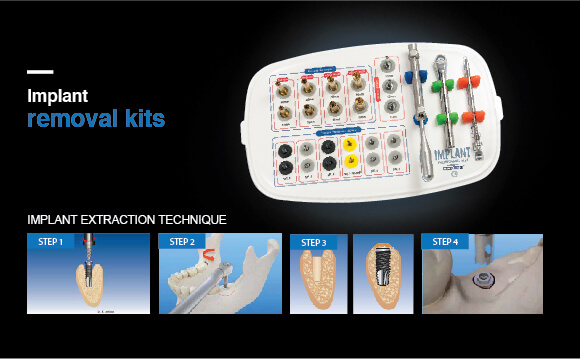Failed Dental Implant
Removing a Failed Dental Implant is a Safe and Relatively Easy Process
Failed dental implant present a common challenge in modern dentistry. Some implants are easy to remove, while others are tightly bonded to the bone, making extraction difficult. The right expertise can make a difference in handling these cases. Skilled professionals minimize damage to the surrounding bone and tissues. At Westcoast International Dental Clinic in Ho Chi Minh City, we focus on removing failed dental implants safely and efficiently. Our approach reduces patient discomfort. The priority is preserving the existing bone and encouraging new bone growth to reduce bone defects after implant removal.
Why Do Dental Implants Fail?
To understand failed dental implants, it's important to distinguish between two types of failures: early and late.
- Early failures occur shortly after the implant has been placed, often within the first few months. In these cases, the bone hasn't fully fused to the implant, making removal easier. The implant may feel loose due to infection, improper placement, or movement during the healing process. This loose condition simplifies the removal process since the implant can often be “unwound” with minimal effort.
- Soft bone implants are especially prone to early failure. These implants tend to stay wobbly and loose, making removal simple.
- Late failures, on the other hand, develop after the implant has been in place for more than a year. In some cases, the implant loosens due to infection or excessive force on the implant site. One common cause of late failure is a condition called peri-implantitis. This is where bacteria accumulate around the neck of the implant, damaging the surrounding bone. Left untreated, this infection leads to further bone loss and discomfort, often requiring the failed dental implant’s removal. Other times, implants fail because they were incorrectly positioned, preventing them from functioning properly. Additional causes include broken implants, fractured components, or screws left in the implant, often from overloading. These issues can be severe and preventable but leave many patients frustrated.
- Bone loss from late failure usually happens gradually, worsening over time. This makes diagnosis of a failing implant difficult, as it slowly integrates with the surrounding bone. When removal is necessary, these implants are more challenging to extract due to their integration with existing bone.
Can All Dental Implants Be Removed Easily?
The ease of removing a failed dental implant depends on several factors. Implants in the lower jaw are typically more difficult to remove than those in the upper jaw. This occurs because of variations in bone density. The amount of time the implant has been in place also matters. Implants that have been set for over 24 months are generally more integrated with the bone. This makes them more challenging to extract.
Sometimes only a few millimeters of bone remain around the implant. Still, the chemical bond between bone and implant can be incredibly strong. The implant’s size, shape, and design also play a role. Larger implants, or those with complex connections, can be more challenging to remove. Additionally, implants positioned near sensitive areas such as nerves or sinuses require extra care to avoid damage to surrounding structures.
Methods for Removing Failed Dental Implants
When it comes to removing failed dental implants, preserving the surrounding bone is a top priority. Westcoast International Dental Clinic employs the latest technologies to ensure as much healthy bone remains intact as possible.
One common method involves using a trough bur. This tool precisely cuts a small portion of bone (around 0.5 to 1 mm) around the implant. It creates space and reduces the tension on the implant, making it easier to remove. Another advanced tool we use is the piezo-electric device. This instrument uses ultrasonic energy to gently remove bone around the implant, further reducing trauma and ensuring a smooth extraction.
Newer removal systems are also being developed. High reverse-torque systems can efficiently remove implants by applying controlled force. These methods, combined with our experienced team, allow us to handle even the most complex implant removal cases.
Can a New Implant Be Placed After Removal?
In some cases, it’s possible to place a new implant immediately after removing failed dental implants. This option is particularly attractive because it saves the patient from undergoing multiple surgeries. Dentists often perform a bone grafting procedure alongside the new implant to support better integration.
However, doctors cannot replace all failed dental implants immediately. If the implant’s removal results in significant bone loss, it may be necessary to wait. This allows time for the area to heal before placing a new implant. A bone graft can still help in these situations, creating a healthier foundation for future implantation.
Is It Possible to Save a Failing Implant?
One of the key debates in implant dentistry today is whether bone grafting or other interventions can save failing implants. In some cases, it is possible to regenerate bone around the implant and give it a second chance. Success rates for this approach vary, with studies showing that only 8–25% of these efforts succeed in the long term.
The biggest risks in trying to save a failing implant are reinfection and the return of peri-implantitis. However, with proper care, cleaning, and management, some patients can prolong the life of a previously failing implant. Success depends on factors such as the patient’s overall health, oral hygiene habits, and whether they smoke.
Another consideration is the width, length and connection of the implant. Wider and longer implants are obviously more difficult because there is more bonding to bone. Narrow implants can be more difficult because the implant top may fracture under high stress during removal. Strange and unusual external connections are present with more than 1000 brands of implants, which can make it difficult for some removal tools to fit into the existing connections. Essentially limiting the easy facilitation of the extraction!
Common Implant Removal Techniques
The key to successful implant removal lies in preserving as much bone as possible. At Westcoast International Dental Clinic, we prioritize using techniques that minimize trauma. The trough bur and piezo-electric devices mentioned earlier are among the most common tools. They allow for precise removal, reducing damage to the bone and increasing the chances of successful reimplantation or bone regeneration.
Another emerging technology involves high-torque systems, which apply a reverse torque to the implant. These systems are capable of removing an implant in just minutes, without damaging surrounding bone.
What Should You Do If You Have a Failed Implant?
If you suspect you have a failed dental implant, consult a qualified dental specialist as soon as possible. At Westcoast International Dental Clinic in Ho Chi Minh City, we provide the safest, most effective treatments available. We’re well-versed in the latest techniques for removing and replacing failed dental implants, ensuring minimal discomfort.
Our team consistently leads in adopting the latest advancements in dental technology. We are constantly improving our skills to ensure patients receive the most advanced care. Whether you’re a full-time resident of Vietnam or a tourist in need of treatment, we’re here to help.
If you’re dealing with failed dental implants, we can guide you through your options. We can ensure you receive the best care available!







